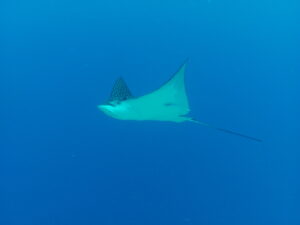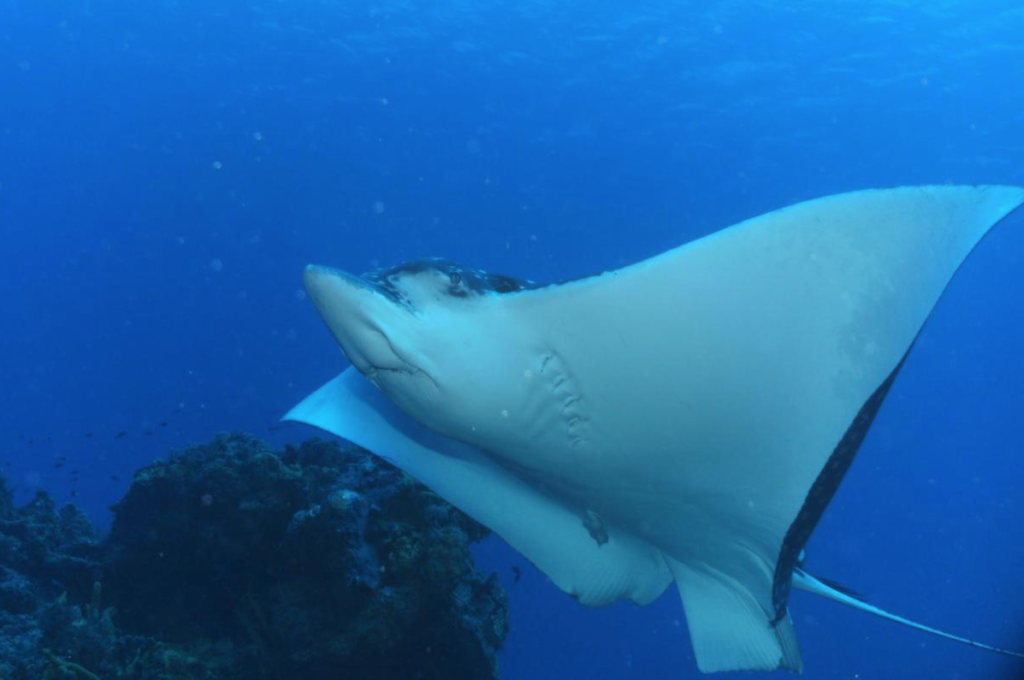HAVE YOU SEEN ONE OF THESE BEAUTIES?
As divers assemble their gear each day, make introductions and prepare for the day’s adventure, the conversation ultimately turns towards which reefs to visit and what people want to see. Almost certainly someone will bring up the bonnet skate, bishop ray, spotted duckbill ray or as it’s most commonly known, the Spotted Eagle Ray.
 Part of the spotted eagle ray’s appeal is it’s graceful appearance as it seems to move almost effortlessly through the water. The desire is also driven by being spotted infrequently (no pun intended), even though they are found across the globe in tropical waters. When looking for them, don’t look in the sand as they don’t bury themselves in the sand like southern rays do. Spotted eagle rays spend most of their time over deeper water in schools of six or more, circling in unison. They only break off on their own to visit the reefs to feed which is when divers are most likely to spot them. Their diet includes shellfish, urchins, octopus, squid and some fishes. They are wary of divers and if followed will likely leave the area. They can be slightly curious, so if you calmly hang in the water column they may come and check you or your bubbles out. So next time you see one, instead of chasing after them banging on your tank, just stay neutrally buoyant and calm and they will stay in the area longer and maybe even circle back to see what you are up to.
Part of the spotted eagle ray’s appeal is it’s graceful appearance as it seems to move almost effortlessly through the water. The desire is also driven by being spotted infrequently (no pun intended), even though they are found across the globe in tropical waters. When looking for them, don’t look in the sand as they don’t bury themselves in the sand like southern rays do. Spotted eagle rays spend most of their time over deeper water in schools of six or more, circling in unison. They only break off on their own to visit the reefs to feed which is when divers are most likely to spot them. Their diet includes shellfish, urchins, octopus, squid and some fishes. They are wary of divers and if followed will likely leave the area. They can be slightly curious, so if you calmly hang in the water column they may come and check you or your bubbles out. So next time you see one, instead of chasing after them banging on your tank, just stay neutrally buoyant and calm and they will stay in the area longer and maybe even circle back to see what you are up to.Spotted Eagle Rays are second in size only to the giant manta ray within the ray family. Females are larger than males and can reach almost 10 feet wide and 16 feet long, including their tail. Check out this video to see one of these gentle giants up close.
They only have a few predators mostly some sharks. Silvertip Sharks and Hammerhead Sharks seem to like them the best. They have been reported to follow a female Spotted Eagle Ray when she is giving birth to feed on the new born pups. Lemon Sharks Bull Sharks and Tiger Sharks have also been known to attack these rays. A Hammerhead Shark was observed in the open ocean biting the pectoral fin of a ray and thus incapacitating it. The shark then used its head to pin the ray to the bottom, pivot around and take the ray in its jaws head first. Check out this video of a Spotted Eagle Ray with what appears to be a big bite out of one of its pectoral fins.
Spotted Eagle Rays do have a few defenses. Their tail includes venomous barbs, and if needed, they can propel themselves completely out of the water to escape a predator. Thankfully they are not sought after by fisherman, but do get caught in nets and long-lines. Experts consider spotted eagle rays “Near Threatened” meaning they have been evaluated for inclusion on the endangered list and may be included in the near future.
Spotted Eagle rays usually mate in the summer months in open water. The mating only lasts a minute or two, but it’s believed to take 12 months before the female gives birth to 1-4 live pups. Spotted eagle rays can live up to 25 years but don’t reach sexual maturity until age 4-6, so there are relatively few cycles to help build the population.
Each Spotted eagle ray’s pattern on spots is unique making it possible to identify individuals. The next time you spot (ok, pun intended) a Spotted Eagle Ray enjoy the experience. It’s one of the many gifts you received that day in the underwater world of Cozumel and maybe on your next dive you’ll be able to see the same one again.


